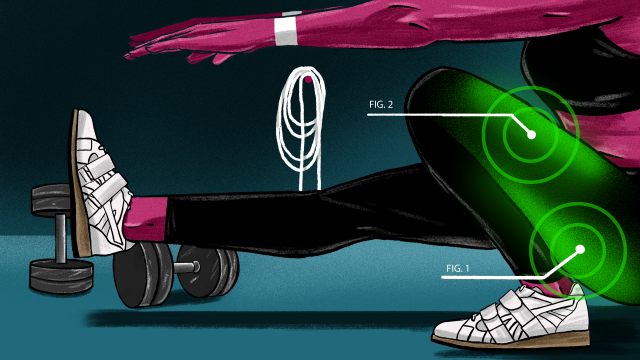Tons of home workouts swear they’ll make you stronger, but many are full of empty promises. If your heart is beating out of your chest and you’ve lost count of how many dozens of reps you’ve done, what you’re doing is probably not a good strength-training workout.
Most of those workouts just aren’t hard enough once you get past the beginner level. If you’re strong enough that you’d be squatting 45 (or 90 or 135) kgs in the gym, your muscles aren’t going to get much of a challenge from air squats, no matter how many of them you do.
Just as with lifting heavy in the gym, appropriately challenging bodyweight moves are the ones that you can only sustain for a small number of reps, and require you to rest before your next set. So let’s look at some moves that actually fit the bill.
Jackknife pullups
In this alternative to pullups, you put your feet up on a block or bench, and then do pullups (or chinups) as usual. It’s easier than a strict pullup, so you may be able to do these even if you can’t do real pullups. And if you can do a few real pullups, you’ll be able to do even more of these.
Pike pushups
This move is harder than a pushup but easier than a handstand pushup. By supporting the weight of your legs on the floor or a bench, you only need your arms to be strong enough to push up the weight of your torso. Make it harder by elevating your feet more and getting your torso upright; make it easier by bringing your feet down.
Shrimp squats
Squats get a lot harder when you take half your legs out of the equation. Shrimp squats are a variation where your free leg is held behind you. They’re harder when you hold your foot and touch your knee to the ground, and easier if you support your free foot lightly on the ground or on a bench or box. Check out the video above for more tips on how to do them.
Two-chair dips
Dips are a great exercise for your arms and chest, and ideally you’ll find a pair of parallel bars to do them on. (Many parks have a set as part of a fitness trail, or you might even luck out and find a well-situated set of railings.) If that’s not an option and you aren’t ready to invest in a pair of gymnastics rings or a freestanding dip station, there’s always the two-chair dip. Put each hand on one chairs, and lower yourself as far as you comfortably can between them, resting your feet on the ground if necessary. To make this move harder, put your hands on the backs of the chairs instead of the seats, or find some other tall surface like a pair of kitchen countertops.
Step ups
Here’s another squat alternative, and you can add weight to this one if you like. These step-ups are not the six-inch aerobics class kind. Get yourself a nice high box (or chair, bench, landscaping boulder, what have you) and step up on top of it and then back down. Make it easier by choosing a lower box; make it harder by slowing down the movement or grabbing a weight.
Inverted rows
Besides pullups, there aren’t many bodyweight exercises that work the biceps and lats. That means inverted rows are one of the most important elements of your bodyweight routine. You can do them on a bar (but again, a railing or something similar may work), or try this version that you can do under a sturdy table.
Harop curls
If your hamstrings are missing deadlifts, try this bodyweight move, which works some of the same muscles. The only thing you need is a place to anchor your feet — a partner can hold them down, or you can wedge your feet under a couch or belt them to a bench. The key feature of a harop curl is that you bend at the hips while leaning forward. For a tougher version, check out the next slide.
Nordic curls
The notorious Nordic curl is a tough but effective exercise. As with pullups, you can work your way toward them using negatives or with bands — or do Harop curls until you’re ready to give this tougher variant a try.
Reverse Nordic curls
This move starts from the same position as a Nordic curl, but you hinge your body backward instead of forward, working your quads rather than your hamstrings. Stronger by Science has a whole article on why this move is great for your quads, but honestly it had me at “works the quads and isn’t a one legged squat.”
Copenhagen planks
Copenhagen planks work your adductor (inner thigh) muscles as well as your core. Think of them as an extra spicy side plank. You can make them easier by doing them from your knee, or from a lower height, or by assisting a bit with your other leg.
Negative pullups
If you’re not satisfied with jackknife pullups, try the negative version of the regular kind. Slowly lowering yourself down to the ground will help to build the same muscles that pull you up. You can step off a box, as in this video, or just jump up to the top of the bar before lowering down.
Ab rollouts
The ab wheel is a wonderful thing, but you don’t actually need a wheel to do it. You can put your hands on gymnastic rings or a TRX style suspension trainer, or just do as in the video above and place sliders under your hands. You can buy sliders, or improvise them with whatever moves easily on your workout surface. (Paper plates work surprisingly well on many floors.)

Leave a Reply
You must be logged in to post a comment.